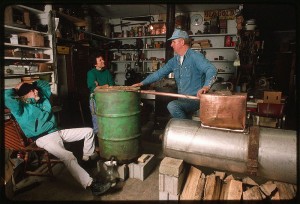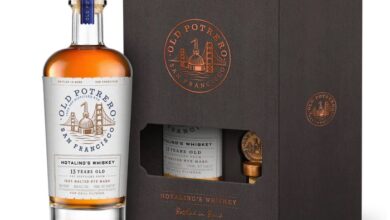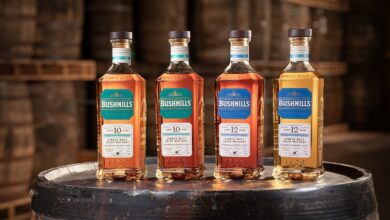Moonshine 101
The Basics of White Lightning: What Is It And How to Enjoy It
By Richard Thomas

(Credit: Joana Thomas)
The growing popularity of moonshine first caught media attention several years ago, when moonshine consumption and even distillation caught on with hipsters. A few years later came white lightning-based reality television, such as The Discovery Channel’s Moonshiners. Now moonshine has a major presence in the micro-distilling sector, moving pretty much in stride with white whiskey as part a new trend in unaged spirits.
Despite all the attention, moonshine (and unaged spirits in general) remain a niche product, of interest to a relatively small group of drinkers, and to mixologists who are looking for the perfect base to use in their upscale cocktails. Along with clear whiskeys in general, moonshine seems to produce confusion in the average drinker, an uncertainty not attached to other clear, “white” spirits (gin, rum, vodka, etc.)
What Exactly Is Moonshine?
One of the problems confronting moonshine is its identity crisis, because as purists are eager to point out, moonshine is usually, but not always, defined as illegally produced liquor. Not only is the formal definition of moonshine not consistent on the matter of legality, but it also almost never specifies a particular type of liquor. Whatever you call it — corn in a jar, white lightning, hooch, mountain dew — moonshine might just as well be anything, unless one is a stickler, in which case it can be anything that is made in defiance of Uncle Sam.

(Credit: Wikimedia Commons)
This lack of definition is reflected in the products that sit under the banner of moonshine, legal or otherwise. The most authentic moonshines are made from either a mostly corn mashbill and then spiked with sugar, or are all-sugar. The latter isn’t really whiskey at all, since by definition whiskey is made from fermented grain. The bottom line is that most old fashioned ‘shiners used sugar in their recipes.
Two other types of alcohol are also frequently dubbed moonshine. One is neutral grain spirits, basically corn vodka. The other is plain old corn whiskey, an unaged whiskey with an 80%+ corn mashbill. While some traditional ‘shiners certainly made corn whiskey, doing so without sugar was not the norm. Most legal moonshines today are either corn whiskey or sugar-spiked corn whiskey, with pure sugar-shine an extreme rarity on store shelves.
What Makes For Good White Lightning
Most distillers in the legal ‘shining business insist that good corn in a jar starts with the corn. Even more than for aged whiskey, the choice and source of grain matters greatly for moonshine, since there is no wood-aging to add flavor later on. At Troy and Sons in Asheville, North Carolina, they chose a white corn variety instead of the usual yellow corn, which puts melon and banana notes into their Platinum Moonshine.

(Credit: S.D. Peters)
Spencer Balentine at Silver Trail Distillery, who appeared on Moonshiners as “the legal guy,” suggests that the choice of corn is part of why legal moonshine is sometimes better than the more “authentic” illegal stuff. Spencer indicates many illegal shiners buy feed corn from a farm store, and says “No one realizes is this type of corn is for animal consumption only and is laced with all sorts of chemicals for weed control which boil directly into the taste of the distilled product. It’s like a metallic foul aftertaste.”
One more advantage of legal over illegal moonshine is that the former is almost always made in copper stills, whereas the latter is almost always made in jury-rigged stainless steel stills. For moonshine as for aged whiskey, stainless steel is a poor substitute for copper in distillation.
Moonshine distillers also generally insist there is a substantial difference between a spirit intended for aging and one that isn’t. As Troy Ball of Troy and Sons explained “Since we always planned to bottle our white spirit rather than age it, it is important that the white spirit be carefully made. We make very deep heads and tail cuts, using only 50 to 60 percent of the distillate – the hearts for bottling.”

(Credit: Troy and Sons)
Tasting Moonshine
“White lightning” to the contrary, burn and bite should play no part in a good swig of moonshine. The prevalence of fiery bite in bad moonshines likely explains its poor reputation. Of such inferior ‘shines, Balentine says “All they get is a ‘burn’ left with a bitter aftertaste, and a desire to never try moonshine again.”
Because aged whiskey draws between 40% and 70% of its flavor from the wood barrel and aging time, by its nature moonshine isn’t complicated, and when well-done its main virtues should be its clarity and smoothness. “We prefer our moonshine to be smooth, and fruit forward” says Ball, while Jim Irvin at Firefly Distilling in South Carolina emphasizes both smoothness and a pleasant nose.
Sometimes how one downs moonshine is as important as the mountain dew itself. In describing how his grandfather taught him how to drink shine, Balentine said “Take a normal sip, then close your lips and let it ease down. After it’s all the way down – open your lips slowly and if it’s good – you’ll catch a fresh corn flavor rising at the sides of the throat and no aftertaste.”
Whether it’s corn-sweet, a little fruity, or even flavored, a good moonshine should have two fundamental qualities, flavor clarity and smoothness, with the latter being critical. Moonshine should be as silvery and sleek as the moonlight it’s named for. If your white lightning sparks, bites, or burns you, it’s not any good.





One Comment